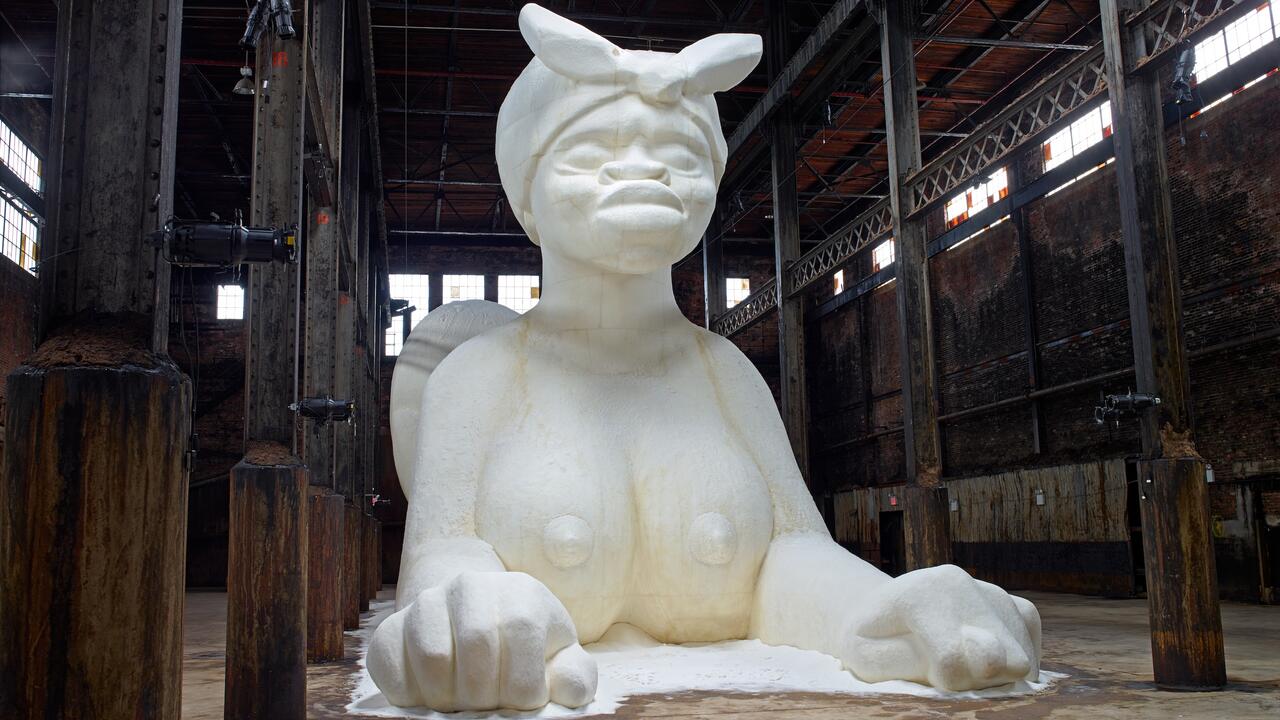Hilton Als on the Films of Kara Walker
‘Kara Walker reinvents painting and drawing’s conventions, while talking about ideas that are epic in scale and deep in blood,’ Als writes
‘Kara Walker reinvents painting and drawing’s conventions, while talking about ideas that are epic in scale and deep in blood,’ Als writes

By the late 1980s, I had pretty much stopped looking at contemporary art. I no longer trusted my eyes to see what the art world had to offer, in part because I couldn’t see the forest for the trees. Back then, the trees glistened with so much gold and so many pendants celebrating boy achievement, amen, that the product of their fame and riches – paintings, photographs, whatever – seemed a byproduct of an afterthought. Something that mattered less than the artist becoming was what he or she had become, and their significance in a commodified world. In that place, sentiment was largely an occasion for irony; bodies existed to be dressed up in costumes that shut feeling away.
This strange moment was made even stranger by the dead and dying bodies that fell and struggled and tried to get up because of – or despite – AIDS. Death on one side; all those glittering prizes on the other. Ultimately, this was too much for me to dissemble or, more accurately, synthesize. I could not see the world whole because it wasn’t. I shut my eyes.

A long-time friend recommended that I take a look at Kara Walker’s work. This was in 1997, by which point Kara had had her auspicious debut at the Drawing Center in New York. There, along with two or three other artists, the then 24-year-old artist had exhibited her 15.25-metre-long wall installation Gone: An Historical Romance of a Civil War as It Occurred b’tween the Dusky Thighs of One Young Negress and Her Heart (1994). In it, Kara turned the 18th-century practice of silhouettes – an activity commonly associated with sweet sentiments, flip books, souvenirs from the mawkish heart – on its head by depicting an America that lived in its own dammed history as though nothing was happening outside of it. By which I mean this: the narrative depicted at the Drawing Center, and the work I saw subsequent to that at Wooster Gardens, which later became the gallery Sikkema Jenkins & Co., was about many things, chief among them the work itself and a new way to do painting and drawing. Which is to say, a reinvention of painting and drawing’s conventions, while talking about ideas that were epic in scale and deep in blood.
All of this made emotional sense to me, sitting, as I was then, in a kind of socio-isolation, one of those AIDS survivors hungry for a reality I could hold on to or even recognize as reality. Looking at Kara’s work, I began to see how all of it – the falling bodies of those felled or chopped-up black figures, all those dead and dying young men and women ignored by their government, local health care systems, not to mention their families – were part of a system: America as an affliction. And, in that America, there was a split between community and the individual. Kara showed, as my dead showed, how power was consolidated, and how it fed the few while making a horrible mess of the many.
Kara’s work was a new reality, a turning point in the history of art, because her art was about society without being social realism. Looked at a certain way, it is abstract without turning away from the world in order to represent internal abstraction – the flow of mind and heart, the language of the self; rather, it depicts the concrete abstraction of humans relating to themselves, to history, to the world. I felt and identified with what she made of a world and what it made of her as we sat at the feet of the dead or the dying.

About that socio-isolation and black and female bodies in particular: in Toni Morrison’s novel A Mercy (2008), the author describes a 17th-century America where slavery, oppression and racism are in the process of institutionalization. It’s a new world of hate. And if you have the language of hate, it opens the door to your hateful imagination, right? People say ‘fag’ or ‘nigger’ and imagine what they’ll do to you next. When I read histories about the America Morrison evokes in her fine novel, I am always struck by how small the world is in which those largely domestic scenes of tightly coiled bitterness and rage unfold, where the American home results directly from human exploitation for personal and economic gain, and the resulting fantasies of domination all ultimately celebrate white masculine power. Mostly, that guy who keeps the keys to the kingdom, which is to say your freedom.
One way those guys went about their business was to make their sickness of mind ‘normal’ through repetition: if you get fucked over once and get fucked over again, who’s to say that the behaviour isn’t normal? Blacks did not speak that language when they were first dumped in America, and then they learned the language to ‘survive’. In learning it, what choice did we have but to take part in its rationale, which included the language of assault, a constant assault that, in our 21st-century world, can result in the law being called because you are gardening while being black, or reading while being black, or walking down the street as yourself. The language of those guys, now and then: Of course, my dick belongs deep in your ass; I colonize your pussy because, like the land I own – the land you work – it is fertile and mine. Those early colonizers didn’t have to think about their terrible acts – their multitude of spiritual, not to mention physical and psychological, transgressions – because in this new land, free of the Church of England, they were at liberty to wander through their subconscious minds and conscious acts. In this new land, they were sovereign.
Still, there was the question of religion. After the first white settlers arrived in Virginia, say, they had their bought-and-sold black bodies build a church. Sometimes, it was erected on a hill, the steeple rising high, and this had to be because, to justify their cruelty, they had to decriminalize it by acting out on consecrated ground. But why stop there? You need an audience for your hatred, and what is an audience but a collective body that you’re trying to convince? To convince those chained bodies of their general unworthiness, their owners stuffed the Bible down their black throats, making sure they ate and believed every word of it because didn’t He say that we were wrong, being the sons of the cursed Ham and all?

When Kara put together her exceptional 2007 exhibition ‘My Complement, My Enemy, My Oppressor, My Love’ at the Whitney Museum of American Art, I was struck by how the walls reminded me of certain churches. This white space was built on the belief that one object was better than another, a world of ‘taste’ legitimized, ultimately, by ownership, economic and aesthetic value. What struck me, watching Kara put up some of the silhouette pieces, was how much it was like her splattering blood on the walls of that belief. One of the things I loved about the experience was how this new kind of ‘action painting’ was comprised of actions that had made the artist – and you, and you, too.
I recall seeing ‘My Complement’ when it travelled to the Musée d’Art Moderne de la Ville de Paris and watching, for the first time, Kara’s debut films: Testimony: Narrative of a Negress Burdened by Good Intentions (2004) and 8 Possible Beginnings or: The Creation of African-America, a Moving Picture by Kara E. Walker (2005). Sitting in that gallery in Paris, I was struck by the texture of the films’ surfaces: they seemed to be excavated from some terrible part of a world where belief, that most common of human precepts, had been buried. They struck me as the loneliest movies I had ever seen.

Loneliness: there was the loneliness of the middle passage, of course, bodies piled high, no one speaking the same language, praying for death, the agony of defeat, because what could be worse than bondage on a sea you did not know the name of – and of being forced to forget your own name in the process? Then there was the loneliness of being with these ‘different’ people who spoke a language you did not know, let alone recognize, and the loneliness of their eroticism – that white phantom jerking off in a face they could not know and what difference did it make anyway? Let me see that black hole of the world in your ass first. Let me fill that black hole of the world with my frenzied nothingness. There’s the loneliness you feel looking at popular entertainments like Disney’s Song of the South (1946) that stops your black hole up with feigned happiness, the bluebirds and flowers of a landscape you made and that made you, lash after lash. There is, too, the loneliness of the artist. The artist is always alone in the world of her sensibility, of course, filling space with the aggression of her belief: See it my way, feel the world at this angle, will you join me in this loneliness?
Working with a small crew, Kara’s films work on many levels at once. They are ‘about’ the manipulation of the object – the puppets who are her characters – just as black bodies have been manipulated by history. In some of the films, the artist appears not as herself, which is to say a character, but as a sensibility whose power lies in her ability to give the story life. In these two early films, Kara sits behind a kind of scrim of history. She is central to the production, but hidden by it, too, the better to give centre stage to the awfulness and beauty of the picture plane.

In curator Yasmil Raymond’s brilliant essay, ‘Maladies of Power: A Kara Walker Lexicon’ (2008), Raymond writes that the artist ‘is not in favour of a generalized anguish. She grants no accusatory voice to any of the characters, nor does she disguise the victim from the victimizer.’ Disguise is such a beautiful word, because it evokes so much: what is hidden and why. When we sit in the dark watching a movie, we are not so much hiding from the action on the screen as we are from ourselves. If movies are about anything at all, they’re metaphors that describe the selves we rarely articulate, rarely know.
In The Devil Finds Work, James Baldwin’s fascinating 1976 study about blacks and the movies, he writes:
The distance between oneself – the audience – and a screen performer is an absolute: a paradoxical absolute, masquerading as intimacy. One does not go to see [movie stars] act; one goes to watch them be. No one, I read somewhere, a long time ago, makes his escape personality black. That the movie star is an ‘escape’ personality indicates one of the irreducible dangers to which the moviegoer is exposed: the danger of surrendering to the corroboration of one’s fantasies as they are thrown back from the screen.
In Kara’s movies – and this is why they move me so – those lines blur as the black figure becomes more American and subject to his own fantasies of domination and revenge and longing. No one is safe in these moving landscapes. In Kara’s films, sexual desire is confused by power or is power which, in turn, festers and blooms. Sometimes, as in 8 Possible Beginnings, when we see a live black woman in a turban, I feel the jolt of history rubbing against the reality of the scene: she is a character-as-slave and also a real person in an artificial world that describes the real world. This admixture of true and false, care and carelessness, dreams and history, sex and domination, frames the films in ways that encourage Kara to step in from time to time to show us just what manipulation looks like and what the artist’s role in manipulation looks like, too.

The movies are free of direct speech or conversation because the pornography of the mind that Kara depicts is often speechless. People – puppets – just act. In the incredible …calling to me from the angry surface of some grey and threatening sea. I was transported. (2007), Kara uses colour for the first time. Her red is red, but it is also a stand-in for blood, just as the splattering of white at the close of Testimony is white the colour – and a stand-in for semen. Colours as fact and fiction.
…calling to me is Sigmund Freud as porn. But, then again, when is he not? Especially when you consider how he believed repression sometimes finds a relief in violence or sex, the explosion of the mind affecting and twisting behaviour. Set in a spooky graveyard, a black woman is buried only to be excavated by a white slave master. A one-legged black man appears. He kills or re-deads, so to speak, the black woman and her white lover before taking over and becoming the dead black woman’s lover, who may or may not be his mother
…calling to me only runs for nine minutes (none of Kara’s movies are longer than 20 minutes), but the funny thing is you may not be aware of its duration because her films run in your mind long after they’re over – or long before the next one has begun. Like poetry, the films are compressed for a number of reasons, one being that history – and, specifically, black history – is long, with more than its share of science-fictional elements, as the great American writer Octavia E. Butler pointed out. One minute we are enslaved, the next, writing stories about twisted dreams of power and the people they imagined we were or wanted us to be.

To film a thought in action entails, of course, having the thought first. But one of the things that black artists and women artists are often denied is having any imagination at all. That stories and dreams are not relevant to their process because they are figures fixed by and in sociological concerns, speaking out of their ‘condition’, as if it were a germ or an illness to be vaccinated against. Thus, intentionally or not, the black female artist – her story – is often regarded as ‘sick’. One way we, the audience, can help alleviate her awful condition is by paying attention to who she is and what the work is, with a great moral sympathy – a kind of pity that absolves us of our guilt in the making of her being and which proves we are not, after all, terrible people. It takes a lot for artists of colour not to succumb to this particular reading of their work and Kara’s films don’t succumb to anything because, despite their time compression, they are a record of profound, porous thought.
A long time ago, the late poet Amiri Baraka said that he wrote plays because he wanted his poems to move, like action paintings. Part of the reason I admire Kara’s films is that they are records of intellection as it happens. Not too long ago, I asked her if she was a film person before she began working in this medium. She said:
Not really. But I kept running across Lotte Reiniger’s work; she was a pioneering German puppeteer-filmmaker. She made the first feature length animated film, technically before Snow White [and Rose Red] (1954), which is regarded as the first feature-length animated film. And I really love the quality of storytelling in those movies and in that genre – cut paper. Her films are aware of their limitations and it helped me to sort of accept my limitations as well as, like, not really being a filmmaker. Or not thinking of myself as a filmmaker, but trying to use the element of motion and time to sort of advance the ... the lack of closure that is experienced with all the other work.
‘From Black and White to Living Color: The Collected Motion Pictures and Accompanying Documents of Kara E. Walker, Artist’ runs at Sprüth Magers, London, UK, from 4 October to 21 December.
Main image: Kara Walker, ...calling to me from the angry surface of some grey and threatening sea. I was transported., 2007, film still. Courtesy: © Kara Walker and Tate Modern, London
This article first appeared in frieze issue 206 with the headline ‘As It Happens’.























